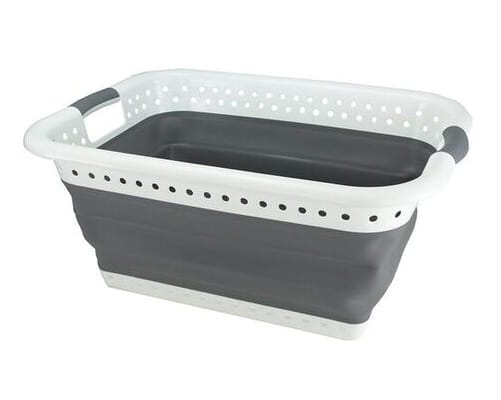A laundry basket is a key feature in everyone’s laundry routine. It’s what you use to carry all the dirty clothes from each room to the laundry on washing day.
When looking for a good laundry basket, some considerations include material, design, and durability. Easy storage is also a plus, especially if you have limited space.
It’s surprising how much of an asset a good basket can be in your home. From typical square designs to collapsible laundry baskets, here’s our roundup of the best laundry baskets Australia – and some tips at the end.
What to Look For In a Laundry Basket
When trying to pick between laundry baskets, there are a few factors to consider.
Be thorough when checking all the product details.
Material

Laundry baskets are usually made of plastic, fabric, metal, or wicker/rattan.
Plastic is a durable and long-wearing material, but it does have its downsides. Plastic baskets can sag over time, become brittle, or warp in the heat. They’re also less aesthetically pleasing.
Metal baskets often come in a wire mesh design, which has the advantage of letting your laundry “breathe” as it sits inside. However, the coating can wear or chip off, which leads to the frame rusting over time.
Wicker or rattan, even if sealed or coated, is prone to water damage and dampness. You’ll need to be proactive about air circulation and dryness to prevent mould or mildew.
On the other hand, fabric baskets can tear, stain, or retain moisture from dirty clothes. Look for sturdy fabric (such as waxed canvas) and strong stitches.
Size and design
Compare the capacity of a laundry basket against the amount of laundry you do every week. Larger baskets let you carry more at a time, but that means each load is heavier.
The design can influence your choice as well. Collapsible laundry baskets, for example, take up less space in storage. On the other hand, rolling baskets are easier to take around the house.
Cost
This is pretty straightforward – your chosen laundry basket should fit in your budget.
Some baskets are pricier given the design or material, but a higher cost doesn’t always mean they’re the “best.”
Best Overall Laundry Basket: Sterilite Ultra Laundry Basket
Large, durable, and easy to use – it doesn’t get much better than the Sterilite Ultra Laundry Basket.
Let this be the one basket you need on laundry day. It’s made of sturdy plastic with comfortable handles and a reinforced rim. The 53L capacity means you can carry more in one load.
Many of the reviews highlight the long-wearing quality of the washing basket, as well as the compact size and design.
Combined with the affordable price point, it’s one of the best traditional laundry baskets you can get.
Best Plastic Laundry Basket: Rubbermaid Hip Hugger Laundry Basket

The key feature of the Rubbermaid Hip Hugger Laundry Basket is the curved design, which rests perfectly on your hip as you carry it.
No more hard plastic digging into your side – just a smooth finish and lightweight material. Plus the three built-in handles make it easy to take around!
This Rubbermaid basket comes in two sizes, L and XL, so you can choose depending on how much laundry you do at a time. Both are durable enough to carry heavy loads over time.
Best Wire Laundry Basket: Yamazaki Home Tosca Laundry Basket
If you’re a fan of the “Nordic” aesthetic, you’ll love this product. The Yamazaki Home Wire Laundry Basket is designed in Japan as part of a “Scandinavian-inspired” line of home essentials.
The basket comes in M and L sizes, and has a metal frame made of alloy steel that’s lightweight but durable. The wooden handles allow for easy carrying, whether extended or collapsed.
Moreover, the design is minimalist and classy, so it brings style to your laundry room. The wire mesh has additional practical value as it lets your laundry “breathe.”
Best Collapsible Laundry Basket: Seymour’s Collapse-A Laundry Basket
Collapsible laundry baskets are great for those who have limited storage space. The foldable design lets them fit in tight spaces in the laundry area.
Seymour’s Collapse-A Laundry Basket is lightweight but sturdy, making it your perfect laundry partner. It’s made of polypropylene and thermoplastic rubber – easy to keep clean.
The basket has a 37L capacity and a 27.5cm height when unfolded, but collapses to just a few centimetres when flat.
You can store this space-saving basket anywhere – a closet, a shelf, or even squeezed between your washers! It’ll make laundry storage that much simpler.
Best Woven Laundry Basket: Denja & Co Woven Laundry Basket
Style meets function in the Denja & Co Woven Laundry Basket. Besides dirty clothing, the baskets can also be used for blankets, dog toys, and even slippers.
These woven baskets are made of thick cotton rope with reinforced handles and strong stitching. They come in two sizes – Large and Extra Large. The XL option can fit up to three large blankets at a time.
The sturdy and hand-woven baskets remain upright even when empty, but can be “collapsed” to fit into smaller spaces when not in use. There’s no plastic in both the product and the packaging as well, so it’s one more way of making your laundry routine eco-friendly.
As a bonus, Denja & Co is an Australian owned brand!
Best Stylish Laundry Basket: Joseph Joseph Tota Laundry Separation Basket
This product doubles as a hamper and basket – combining convenience with aesthetics in one.
The Joseph Joseph Tota Laundry Separation Basket is one of our favourite stylish laundry baskets. It comes in several colours, from sophisticated black to classy ecru. There are two materials (cotton or plastic) and two sizes (60L and 90L).
One favourite feature is the split compartment, making laundry organisation easier. You can separate dirty washing the two (or three) tote bags in the basket compartments.
Then when it’s time for laundry, simply lift each bag out by the sturdy handles. There’s a “helper handle” at the bottom to make emptying laundry easier.
Once empty, you can slot the bags right back into the compartments – or toss them into the washing machine to clean them first!
Best Baby Laundry Basket: INough Baby Hamper
Babies and toddlers go through a lot of clothes in a day, so keeping a laundry basket in their room can be very helpful. The INough Baby Hamper isn’t just functional – it comes in several adorable designs as well!
This baby laundry basket has a large capacity of 40L, so it can hold a lot of dirty clothing. The metal frame helps it stay upright and freestanding, but it can fold up for convenient storage.
Each INough Baby Hamper is lightweight and easy to carry around, but sturdy enough to hold clothes and even toys.
You can clean the hamper by wiping it with a soft cloth or baby wipe, or spot clean with some soapy water then air dry.
Best Laundry Hamper: HomeHacks Freestanding Laundry Hamper
These hampers are great for many reasons – such as the large 75L capacity, the sturdy metal framing, and the PEVA waterproof material.
Moreover, the HomeHacks Freestanding Laundry Hamper has a collapsible space-saving design, so it can fold up when not in use.
The hamper is made of sturdy polyester and cotton with a waterproof coating. The two long handles are reinforced with durable stitching, so you can carry a full load without worry.
Note that the HomeHacks hamper isn’t machine washable, but it’s still easy to clean! You can use a damp sponge or cloth to wipe dirt off the surface, then let it air dry.
Best Laundry Trolley: Hills Classic Laundry Trolley
No more bending down to grab another shirt from the washing basket and hang it up. The Hills Laundry Trolley has a lightweight but strong metal frame and an integrated basket for your pegs and clothespins.
The trolley wheels feature a locking system that holds the trolley in place and prevents it from collapsing. When unlocked and not in use, the trolley folds up for easy storage.
This laundry trolley can hold baskets up to 630mm x 420mm x 229mm. Assembly is also straightforward, as the package comes with an assembly tool.
Best Rolling Laundry Basket: Yamazaki Home Tosca Rolling Basket
Don’t want to carry a basket everywhere? No problem! The Yamazaki Home Tosca Rolling Basket lets you wheel your laundry around instead.
The rolling laundry basket features a tall wire basket on four wheels – two typical swivel casters, and two that lock. That lets you “lock” the trolley in place while you’re loading dirty clothes and other items.
It also has a comfortable wood handle and a capacity of about 54L.
Moreover, the basket itself is made from powder-coated steel, making it water-repellent and easy to clean. The smooth finish ensures your clothes don’t snag when you toss them in.
Honorary Mention: SimpleHouseware 3-Bag Laundry Sorter Rolling Cart
This one might feel excessive, but it makes sorting and organisation so much more efficient. The SimpleHouseware 3-Bag Laundry Cart features three heavy-duty bags to sort your dirty laundry right then and there.
Some key features include the sturdy steel frame and wheel brakes, so you can tow the cart around your home and park it when collecting laundry.
The three bags can carry about 50L each, so you can carry more in one go. They’re made of heavy-duty and waterproof polyester which you can wipe clean.
Additionally, the bags aren’t fixed – they rest on the horizontal bars with hooks. So you can lift each bag using the side handles to empty it out.
Do I Need to Clean a Laundry Basket and Hamper?
Yes, you do! It’s good to clean your basket and hamper to maintain proper hygiene.
Wash your laundry basket around once a month, although you can do it once a week if you do laundry frequently. Meanwhile, you should wash your laundry hamper once a week.
For fabric baskets and hampers, check if they’re machine washable – that’ll make them easier to clean.
Plastic and metal wire baskets and hampers can be wiped with soap and water or an all-purpose cleaner. You could even ask your house cleaner to give it a quick wipe while they clean the rest of your home.
FAQs about Washing Baskets

Got more questions about laundry baskets and hampers before you make your choice? We’ve got you covered!
What’s the difference between a laundry basket and a laundry hamper?
Laundry hampers are meant to stay in place, like in your bedroom or bathroom. They’re where you toss your dirty clothes and linens as temporary storage.
On the other hand, laundry baskets (or washing baskets) are what you use to carry dirty laundry from your room to the laundry room.
This means there are some feature differences – for example, baskets tend to be wider and open on the top so they can carry more items.
Meanwhile, hampers could be narrower or have a smaller footprint since they stand in a corner or a closet. They might also be more aesthetic to complement the decor of a room.
What’s the best material for a laundry basket?
Common materials used for laundry baskets include plastic, wicker or rattan, and fabric.
Plastic or metal are the most durable and long-wearing materials for a laundry basket.
Should laundry baskets have lids?
Not necessarily! This mostly comes down to personal preference – although a laundry basket lid is a good consideration if your household has pets or small children.
The lids will prevent curious hands or snouts from getting into your laundry. Get them for your hampers as well.
Should you have a clean and dirty laundry basket?
It’s not necessary, but you can if you want. It isn’t “unhygienic” to use the same basket for clean and dirty laundry – you can even wipe the basket in between loads if you’re worried about dirt.
A standard all-purpose cleaner or disinfectant spray is enough to quickly clean your washing baskets.
For extremely dirty clothes, or if someone is sick, you can skip the hamper or basket and take the dirty laundry directly to the washer.
If you want to be more efficient with laundry, you can have one large basket for dirty laundry and several smaller ones for sorting clean laundry.
This way, you can carry that small basket to the designated room instead of having to sort through clean clothes to find the correct ones each time.











